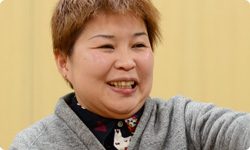All of the games in Game & Wario, including multiplayer ones, are designed to be played using the Wii U GamePad alone, rather than the Wii Remote. What led you to take this approach?
This originated in the initial idea of having this game pre-installed on the Wii U console, as not every Wii U user will have a Wii Remote.
Ah, I see.
Then as development proceeded, it was a little like Columbus’s egg10. We discovered that there’s a whole range of ways to use the Wii U GamePad, which enabled multiple players to take part. The GamePad is incredibly versatile, and this was a major factor in the sheer amount of ways to play we came up with. For starters, you have a large touch screen...10. Columbus’s egg: a discovery or idea that, once realised, seems simple or obvious. It originates from a story about explorer Christopher Columbus, who challenged a vocal critic to stand an egg on its tip. The critic believed it was impossible, until Columbus struck the egg’s tip, flattening it and allowing the egg to stand upright with ease.
And then you also have the gyroscope.
That’s right. And you’ve also got an accelerometer11, a camera, a microphone... It really has everything. So during the process of developing this game, we would constantly be thinking about how we could make full use of the GamePad’s functionality. Whatever idea we came up with, it seemed possible to create it. We were constantly trying to come up with completely original ideas, things that had never existed before.11. Accelerometer: An electrical circuit element that can detect changes in speed.
Looking at the 16 different games, it’s not as if there is one unifying thread that runs neatly through them all.
That’s true.
Well, once we’d decided we were going to make a WarioWare game, it actually made us go the other way...
We wanted to really mix things up.
We were always conscious of wanting to make the games distinct from each other. As we were using WarioWare as the container which would hold all the games, we wanted to highlight the fact that each game had been created by a particular character. Up to now, WarioWare titles have always been about quick-fire responses, but this time round...
Well, from the start, this game wasn’t structured like a WarioWare title.
That’s why each game has so much content. The games included in this title are different from the usual WarioWare microgames. You’ve put a great deal of energy and effort into each one.
Yes, that’s right. The development team actually avoided using the term ‘minigame’. If you use that term, you end up being conscious of the limitations it implies, and this has an impact on the games you come up with. If, on the other hand, you think of each game as being a game in its own right, you’ll make them with the idea that each of these games could be sold individually. In fact, we were so conscious of this that we ended up coming up with a separate title screen for each of the 16 games.

Yes, indeed. The title screens are very distinctive. Each one has its own individual character.
The image that we had in mind was that of the old Nintendo Entertainment System game boxes. The front of the box would always be adorned with a gorgeous image, but then when you came to play the game, the actual graphics would look rather limited in comparison.
Yes, you’re right! (laughs)
What we were trying to capture was that fun feeling, when you sensed the gap between these images. That’s why we gave designers the freedom to come up with their own graphics, all of which were quite distinct.
That’s how they’ve ended up being so painstakingly detailed.
There are even pictures of things that don’t actually appear in the game itself!
So you’ll find yourself thinking: “Erm, is that meant to be a picture of the character from the game?” (laughs)
Yes, that’s right! (laughs)
Well, we had five or six designers...
No, I think there were a few more than that. Designers from INTELLIGENT SYSTEMS were also working on this.
I oversaw the work on the title screens, and there were times when I’d reject an image, saying: “You just haven’t gone far enough yet!” (laughs)
So you would say: “It’s just not lavish enough!” (laughs)

That’s right! (laughs)
I’d say that the cost of each individual title screen in the game was higher than the title screen of a normal game. It’s unusual to have that much attention paid to a title screen, so I think players will be rather taken aback when they see them for themselves.
The title screens are really on a par with the packaging of the game itself.
There’s a really odd kind of boastfulness about those title screens. (laughs)
(laughter)
Well, that’s an aspect of the game where we didn’t want to cut corners, and where we really decided to pull out all the stops. (laughs)
Well, this is WarioWare after all! (laughs)
Yes, that’s right! (laughs)
We even came up with separate menus and stage select screens for each game, so in terms of the amount of effort it took, it was as if we were working on 16 different games.
So you weren’t just reusing the same things for different games.
No, we weren’t.
Then, when it came to the controls, you had games that used the touch screen, others that used the gyroscope, and then there were others...
There are games where you hold the Wii U GamePad vertically, ones where you hold it horizontally...
All of the different control methods meant that we went through quite a lengthy process of trial and error in order to make the interface and instructions as clear as possible for the player.
And we really didn’t stint on content with these games.
That’s right. So for instance, on 'GAMER', which features 9-Volt , you actually have old favourites from previous WarioWare titles used in the game.
So in ‘GAMER’ alone you get about as many microgames as you would in a regular WarioWare title, isn’t that right?
There are 22 microgames that feature in ‘GAMER’, which is about ten percent of the total number of microgames that have appeared in the series up to now. Then on top of that, you have all of the new game elements which required a great deal of effort. So I really think this is a complete game in its own right.
Due of the structure of the game, and the sheer amount of effort that each game required, it meant that you needed a lot of assistants lending their support right at the end.
Yes, that’s right.
Let’s talk about that now, shall we? About the “Nintendo All-Star Assistance” you required.
Okay! (laughs)
It really was just like Super Smash Bros.!
(Editor’s note: The Japanese title for the original Super Smash Bros. on Nintendo 64 translates to “Nintendo All-Star: Super Smash Bros.”)

Ah, is that how you thought of it?
Well, the people who helped us were the “Nintendo All-Stars”, so that was my way of describing it! (laughs) A lot of Nintendo directors and producers got together and came up with all kinds of ideas. I remember thinking: “Nothing like this has ever happened before!”
Yes, it really was a first. Since the Software Planning and Development Department first came into existence, there has never been a case of all the development teams coming together to give their support to a single game.
© 2024 Nintendo.